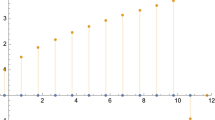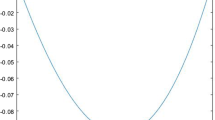Abstract
This paper studies a fractional difference equation of two point boundary value problem (BVP) type, which is recognized as the ‘discrete’ BVP. Certain cases are expressed under which the discrete boundary value problems (DBVP) will have a single solution. The novelty hither comprises a method selection of metric and employment of Hölder’s inequality. This attitude allows the related functions to be contractive, which were earlier non-contractive in classical regularities. This consequently qualifies an enhanced application of Banach’s fixed point theorem for classifying a more extensive framework of issues than those which appeared in the current designs.
Similar content being viewed by others
1 Introduction
In [1], Diaz and Osler concluded that the fractional difference by choice is a normal method of letting the index of differences, in the criterion appearance for the nth difference, to be any number (real or complex). Farther along, Hirota [2] employed the fractional difference operator (FDO) for any real number utilizing a Taylor’s series. In [3], Nagai assumed different description of FDO by adapting Hirota’s [2] concept. Newly, in [4], Deekshitulu and Mohan improved Nagai’s definition [3]. In [5], Jumarie suggested another formula of fractional difference operator, of which the leading features are a new fractional Taylor series and its companion Rolle’s formula which are employed to non-differentiable functions. In [6, 7], the authors generalized Gâteaux derivative by employing a fractional discrete operator for a Jumarie fractional operator. The method of finding solutions was based on critical point theorems of finite dimensional Banach spaces. Other techniques can be found in [8] and [9].
Investigators in the areas of control systems, neural networks, computer science, food processing and economics rely on mathematical modeling because it surely affects nonlinear difference equations. Consequently, many novelists have widely established various procedures and patterns, such as fixed point theorems, upper and lower solutions and Brouwer degree, to consider discrete problems [10, 11]. The investigation of fractional differential equations (FDE) was started to establish the existence and uniqueness of findings for various classes of FDE. Moreover, the theory of integro-differential equations has been almost settled parallel to the theory of FDE. However, the theory of fractional difference equations led to a very minor development of itself.
This paper aims to study a fractional difference equation of two point BVP type, which was realized as the discrete BVP. Certain classes are formulated in which the discrete boundary value problems will have a single solution. The novelty hither comprises a method selection of metric and employment of Hölder’s inequality. This investigation allows the related functions to be contractive, which were earlier non-contractive in classical regularities. This work, unlike those which appeared in the current designs, consequently grants the enhanced applications of Banach’s fixed point theorem for classifying an extensive framework of issues.
2 Main methods
This section concerns some concepts as well as preliminaries.
Definition 2.1
Let \(\wp\in\mathbb{R}\) and \(k \in\mathbb{Z}\) such that \(k- 1 < \wp\leq k\). The FDO ∇ of order ℘, with step length κ, is introduced as
where the extended binomial coefficient, for \(\varepsilon\in\mathbb {R}\), \(n \in\mathbb{Z}\), is defined by
The above formula is hard to study the properties of findings (solutions). Therefore, Mohan and Deekshitulu [12] introduced the following formula for \(\kappa=k=1\).
Definition 2.2
The FDO of order \(0<\wp<1\) is given by
And the FDO of order ℘ is given by
Remark 2.1
The solution for the nonlinear fractional difference equation
is given by the form
where
stands as the extended binomial coefficient and \(\phi: \mathbb{N}_{0} \rightarrow\mathbb{R}\) denotes a function of n. It is clear that \(0\leq\beta(m,\wp;j)\leq1\) for \(\wp\in[0,1]\). Moreover, the coefficient \(\beta(m,\wp;j)\) satisfies
where \((x)_{m}:= \frac{\Gamma(x+m)}{\Gamma(x)}\) is the Pochhammer symbol, which satisfies
Example 2.1
Consider the problem
where α and γ are nonnegative functions on n; thus the solution can be expressed by
This paper studies a boundary value problem that includes a nonlinear difference equation. Let \(\phi: [0,N] \times\mathbb{R} \rightarrow\mathbb{R}\) be continuous and consider the discrete BVP
where a, b, c are constants and \(0< \wp<1\), \(0< \ell=N/n < N\), \(t_{i}=i \ell\), \(i=0,1, \ldots,n\).
3 Main findings
The main result is as follows.
Theorem 3.1
Let \(\phi: [0,N] \times \mathbb{R} \rightarrow \mathbb{R}\) be continuous and \(a+b \neq0\). Assume that there exist constants \(L>0\), \(\lambda\in(0,N)\) and \(p>1\). If
and
where
with
then problem (1) has a unique solution for each \(|\frac{ \ell^{\wp}}{a+b}|\leq \lambda\).
Proof
Consider the metric space \((\Xi :=\mathbb{R}^{n+1}, d_{p})\) and for all \(\mu,\nu\in\Xi\),
It is easy to show that \((\Xi,d_{p})\) is a complete metric space for all \(p \geq1\). In view of Remark 2.1, it can be shown that the discrete BVP (1) is equivalent to the summation equation
where
Our aim is to prove that (2) has a unique solution. We define the operator
So that
Obviously, \(\Lambda(\mu)\) is bounded
where o is the zero element in \(\mathbb{R}^{n+1}\).
We aim to show that \((\Lambda\mu)=\mu\) for a unique \(\mu\in\Xi\). Since ϕ is well defined on \([0,N] \times \mathbb{R}\), it follows that \(\Lambda: \Xi\rightarrow\Xi\). We proceed to show that Λ is a contraction mapping on Ξ with respect \(d_{p}\), i.e., there is a constant \(0<\sigma<1\) such that
A computation yields, for \(0< \wp<1\),
This yields
Hence, we obtain
Consequently, we have
Thus, for all \(\mu, \nu\in\mathbb{R}^{n+1}\), we attain
where \(0< \sigma:= \lambda L\overline{\Phi} <1\). Thus, Λ is a contraction mapping on \(\mathbb{R}^{n+1}\) with respect to the \(d_{p}\) metric and therefore, all of the assumptions of Banach’s fixed point theorem are accorded. So, there is a unique \(\mu\in \mathbb{R}^{n+1}\) such that \(\Lambda\mu=\mu\), giving the existence of a unique solution to problem (1). □
Theorem 3.2
Let \(\phi: [0,N] \times \mathbb{R} \rightarrow \mathbb{R}\) be continuous and \(a+b \neq0\). Assume that there exist constants \(L>0\), \(\lambda\in(0,N)\); \(p>1\), \(q>1\) such that \(\frac{1}{p}+\frac{1}{q}=1\). If
and
then problem (1) has a unique solution for each \(\ell^{\wp}\leq\lambda\).
Proof
Operator (3) implies
An application of Hölder’s inequality yields
By applying the boundary condition and taking account of \(0\leq \beta(m,\wp;j)\leq1\), we obtain
Thus, we attain
Consequently, this leads to
For all \(u, v \in\mathbb{R}^{n+1}\), we have
Thus, we conclude that
with
Hence, Λ is a contraction mapping on \(\mathbb{R}^{n+1}\) with respect to the \(d_{p}\) metric and so, all of the conditions of Banach’s fixed point theorem are achieved. Therefore, there is a unique \(\mu\in\mathbb{R}^{n+1}\) such that \(\Lambda\mu=\mu\), yielding the existence of a unique solution to problem (1). □
As a special case, for \(p=q=2\), we have the following result.
Corollary 3.1
Let \(\phi: [0,N] \times \mathbb{R} \rightarrow \mathbb{R}\) be continuous and \(a+b \neq0\). If there exist \(L>0\) and \(\lambda\in(0,N)\) such that
then problem (1) has a unique solution.
Example 3.1
Consider the problem
where \(0< \ell=1/4 < 1\). For \(\lambda=|\frac{\ell^{\wp}}{2}|\approx0.25\), \(a=b=1\), then the condition of Corollary 3.1 is satisfied for
Hence problem (6) has a unique solution.
Theorem 3.3
Let \(\phi: [0,N] \times \mathbb{R} \rightarrow \mathbb{R}\) be continuous and \(a+b \neq0\). Assume that there exist constants \(L>0\), \(\lambda\in(0,N)\). If
and
then problem (1) has a unique solution for each \(|\frac{\ell^{\wp}}{a+b}| \leq\lambda\).
Proof
Consider the metric space \((\Xi:=\mathbb{R}^{n+1}, \partial)\) and for all \(\mu,\nu\in\Xi\),
It is easy to show that \((\Xi,\partial)\) is a complete metric space. Operator (3) yields
Taking the max, we obtain
Thus, we conclude that
with
Hence, Λ is a contraction mapping on \(\mathbb{R}^{n+1}\) with respect to the ∂ metric and so, all of the conditions of Banach’s fixed point theorem are satisfied. Hence, there is a unique \(\mu\in \mathbb{R}^{n+1}\) such that \(\Lambda\mu=\mu\), implying the existence of a unique solution to problem (1). □
Example 3.2
Consider problem (6) with
and \(0< \ell=1/4 < 1\). For \(\lambda=0.25\), \(N=a=b=1\), then the condition of Theorem 3.3 is achieved for
Hence problem (6) has a unique solution.
Example 3.3
Assume problem (6) with
and \(0< \ell=1/4 < 1\). If \(\lambda=0.9\), \(N=1\), \(a=-1\), \(b=2\), then the condition of Theorem 3.3 is satisfied for
Hence, problem (6) has a unique solution. It is interesting to note that the condition of Corollary 3.1 does not hold for
Next, we study a boundary value problem that includes a nonlinear difference equation of Volterra type of order ℘. Let \(\phi: [0,N] \times\mathbb{R} \rightarrow\mathbb{R}\) be continuous and consider the discrete BVP
where a, b, c are constants, \(0< \ell=N/n < N\), \(t_{i}=i \ell\), and ϕ, f are any two functions defined for \(i, k \in \mathbb{N}_{0} \), \(k \leq i\). The solution of problem (7) can be expressed as follows:
where
We have the following existence result.
Theorem 3.4
Let \(\phi: [0,N] \times \mathbb{R} \rightarrow \mathbb{R}\) and \(f: [0,N] \times[0,N] \times\mathbb{R} \rightarrow \mathbb{R}\) be continuous and \(a+b \neq0\). Assume that there exist constants \(L_{1}>0\), \(L_{2}>0\), \(\lambda\in(0,N)\); \(p>1\), \(q>1\) such that \(\frac{1}{p}+\frac{1}{q} =1\). If
and
then problem (7) has a unique solution for each \(0< \ell^{\wp}\leq\lambda\).
Proof
Consider the complete metric space \((\Xi:=\mathbb{R}^{n+1}, d_{p})\) and for all \(\mu,\nu\in\Xi\),
Our aim is to prove that (7) has a unique solution. We define the operator
such that
Thus the operator (9) implies
By employing Hölder’s inequality, we receive
By applying the boundary condition and the fact that \(\beta(m,\wp;j)<1\),
and utilizing (10), we obtain
Consequently, this leads to
Now, for all \(u, v \in \mathbb{R}^{n+1}\), we have
Thus, we conclude that
with
Hence, ϒ is a contraction mapping on \(\mathbb{R}^{n+1}\) with respect to the \(d_{p}\) metric and so, all of the conditions of Banach’s fixed point theorem are satisfied. Therefore, there is a unique \(\mu\in\mathbb{R}^{n+1}\) such that \(\Upsilon\mu=\mu\), yielding the existence of a unique solution to problem (7). □
References
Diaz, JB, Olser, TJ: Differences of fractional order. Math. Comput. 28, 185-202 (1974)
Hirota, R: Lectures on Difference Equations. Science-sha, Tokyo (2000)
Nagai, A: Discrete Mittag-Leffler function and its applications. New developments in the research of integrable systems: continuous, discrete, ultra-discrete. RIMS Kokyuroku 1302, 1-20 (2003)
Deekshitulu, G, Mohan, JJ: Fractional difference inequalities. Commun. Appl. Anal. 14(1), 89-97 (2010)
Jumarie, G: Fractional Differential Calculus for Non-Differentiable Functions: Mechanics, Geometry, Stochastics, Information Theory. Lambert Academic Publishing, Saarbrucken (2013)
Ibrahim, RW, Jahangiri, JM: Boundary fractional differential equation in a complex domain. Bound. Value Probl. 2014, 66 (2014)
Ibrahim, RW, Jalab, HA: Discrete boundary value problem based on the fractional Gâteaux derivative. Bound. Value Probl. 2015, 23 (2015)
Yang, X-J, Baleanu, D, Khan, Y, Mohyud-Din, S-T: Local fractional variational iteration method for diffusion and wave equations on Cantor sets. Rom. J. Phys. 59(1-2), 36-48 (2014)
Zhang, Y-Z, Yang, A-M, Long, Y: Initial boundary value problem for fractal heat equation in the semi-infinite region by Yang-Laplace transform. Therm. Sci. 18(2), 677-681 (2014)
Candito, P, Bisci, GM: Existence of two solutions for a second-order discrete boundary value problem. Adv. Nonlinear Stud. 11, 443-453 (2011)
Ibrahim, RW: Fractional complex transforms for fractional differential equations. Adv. Differ. Equ. 2012, 192 (2012)
Mohan, JJ, Deekshitulu, GVSR: Fractional order difference equations. Int. J. Differ. Equ. 2012, Article ID 780619 (2012)
Acknowledgements
The authors would like to thank the referees for giving very useful suggestions for improving the work. This research is supported by Project No. RG312-14AFR from the University of Malaya.
Author information
Authors and Affiliations
Corresponding author
Additional information
Competing interests
The authors declare that there is no conflict of interests regarding the publication of this article.
Authors’ contributions
Both authors jointly worked on deriving the results and approved the final manuscript.
Rights and permissions
Open Access This article is distributed under the terms of the Creative Commons Attribution 4.0 International License (http://creativecommons.org/licenses/by/4.0/), which permits unrestricted use, distribution, and reproduction in any medium, provided you give appropriate credit to the original author(s) and the source, provide a link to the Creative Commons license, and indicate if changes were made.
About this article
Cite this article
Ibrahim, R.W., Jalab, H.A. Existence of a class of fractional difference equations with two point boundary value problem. Adv Differ Equ 2015, 269 (2015). https://doi.org/10.1186/s13662-015-0609-1
Received:
Accepted:
Published:
DOI: https://doi.org/10.1186/s13662-015-0609-1




